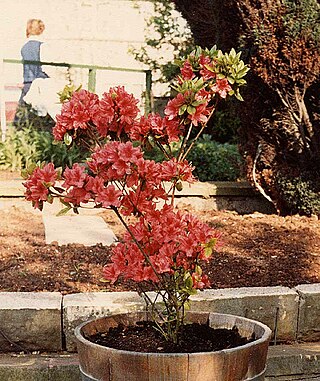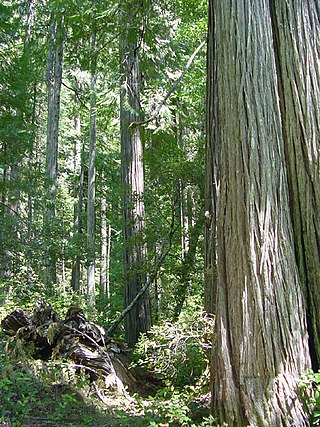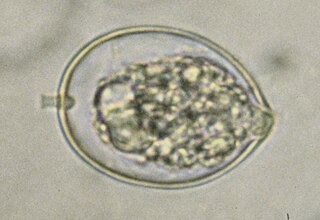
Azaleas are flowering shrubs in the genus Rhododendron, particularly the former sections Tsutsusi (evergreen) and Pentanthera (deciduous). Azaleas bloom in the spring, their flowers often lasting several weeks. Shade tolerant, they prefer living near or under trees. They are part of the family Ericaceae.

Chamaecyparis lawsoniana, known as Port Orford cedar or Lawson cypress, is a species of conifer in the genus Chamaecyparis, family Cupressaceae. It is native to Oregon and northwestern California, and grows from sea level up to 4,900 feet (1,500 m) in the valleys of the Klamath Mountains, often along streams.

Phytophthora is a genus of plant-damaging oomycetes, whose member species are capable of causing enormous economic losses on crops worldwide, as well as environmental damage in natural ecosystems. The cell wall of Phytophthora is made up of cellulose. The genus was first described by Heinrich Anton de Bary in 1875. Approximately 210 species have been described, although 100–500 undiscovered Phytophthora species are estimated to exist.

Phytophthora ramorum is the oomycete known to cause the disease sudden oak death (SOD). The disease kills oak and other species of trees and has had devastating effects on the oak populations in California and Oregon, as well as being present in Europe. Symptoms include bleeding cankers on the tree's trunk and dieback of the foliage, in many cases leading to the death of the tree.

Phytophthora cinnamomi, also known as cinnamon fungus, is a soil-borne water mould that produces an infection which causes a condition in plants variously called "dieback", "root rot", or, "ink disease".
Root rot is a condition in which anoxic conditions in the soil or potting media around the roots of a plant cause them to rot. This occurs due to excessive standing water around the roots. It is found in both indoor and outdoor plants, although it is more common in indoor plants due to overwatering, heavy potting media, or containers with poor drainage. The leaves of plants experiencing root rot often yellow and die, and if allowed to continue, the condition can be fatal.

Phytophthora palmivora is an oomycete that causes bud-rot of palms, fruit-rot or kole-roga of coconut and areca nut. These are among the most serious diseases caused by fungi and moulds in South India. It occurs almost every year in Malnad, Mysore, North & South Kanara, Malabar and other areas. Similar diseases of palms are also known to occur in Sri Lanka, Mauritius, and Sumatra. The causative organism was first identified as P. palmivora by Edwin John Butler in 1917.

Phytophthora cactorum is a fungal-like plant pathogen belonging to the Oomycota phylum. It is the causal agent of root rot on rhododendron and many other species, as well as leather rot of strawberries.

Phytophthora × cambivora is a plant pathogen that causes ink disease in European chestnut trees. Ink disease, also caused by Phytophthora cinnamomi, is thought to have been present in Europe since the 18th century, and causes chestnut trees to wilt and die; major epidemics occurred during the 19th and 20th centuries. P. cinnamomi and P. × cambivora are now present throughout Europe since the 1990s. Ink disease has resurged, often causing high mortality of trees, particularly in Portugal, Italy, and France. It has also been isolated from a number of different species since the 1990s, including:
Phytophthora citrophthora, also known as brown rot of citrus, is a soil borne oomycete that infects several economically important citrus crops. A diagnostic symptom of P. citrophthora is gummosis, wherein lesions around the base of the tree exude sap. Other common symptoms include dark longitudinal lesions forming at the soil line, a sour smell, and eventual cracking of the bark. Advanced symptoms include yellowing and necrosis of the tree canopy. Girdling action caused by the pathogen around the trunk can often cause the collapse of the tree. Resistant lemon varieties have been developed and their implementation has been effective at controlling the spread of the disease. Fruits that have been infected with P. citrophthora exhibit symptoms of brown rot characterized by a distinct odor. This disease is most active in the moderate temperatures of spring, fall, and winter months, opposite of most other Phytophthora species.
Phytophthora syringae is an oomycete plant pathogen known to infect nursery plants, particularly apple and pear trees. It infects plants through wounded areas and is most pathogenic during cold, wet weather.
Phytophthora fragariae is a fungus-like (oomycete) plant pathogen that causes red stele, otherwise known as Lanarkshire disease, in strawberries. Symptoms of red stele can include a red core in the roots, wilting of leaves, reduced flowering, stunting, and bitter fruit. The pathogen is spread via zoospores swimming through water present in the soil, released from sporangia.

Phytophthora lateralis is a soil-borne plant pathogen that causes cedar root disease in Lawson cypresses in Northern USA. This pathogen was first noted to cause disease in around 1920 on nursery stock near Seattle. Pacific yew is also vulnerable to P. lateralis but less susceptible than Lawson cypress trees, and tree mortality has only been observed in areas where C. lawsoniana trees were also infected. Asiatic species of Chamaecyparis are generally described as resistant to P. lateralis, although this pathogen is occasionally isolated from Chamaecyparis obtusa in nurseries.
Rhododendron album is a species of plant in the family Ericaceae. It is endemic to Java in Indonesia. It is a vulnerable species threatened by habitat loss.
Phytophthora iranica is a plant pathogen that infects the roots of Myrtle. It was discovered in a commercial nursery in Sardinia, Italy.

Phytophthora kernoviae is a plant pathogen that mainly infects European beech and Rhododendron ponticum. It was first identified in 2003 in Cornwall, UK when scientists were surveying for the presence of Phytophthora ramorum. This made it the third new Phytophthora species to be found in the UK in a decade. It was named Phytophthora kernoviae after the ancient name for Cornwall, Kernow. It causes large stem lesions on beech and necrosis of stems and leaves of Rhododendron ponticum. It is self-fertile. It has also been isolated from Quercus robur and Liriodendron tulipifera. The original paper describing the species, stated it can infect Magnolia and Camellia species, Pieris formosa, Gevuina avellana, Michelia doltsopa and Quercus ilex. Since then many other plants have been identified as natural hosts of the pathogen. Molecular analysis has revealed that an infection on Pinus radiata, recorded in New Zealand in 1950, was caused by P. kernoviae. The pathogen was also noted on Drimys winteri, Gevuina avellana, Ilex aquifolium, Quercus ilex, Vaccinium myrtillus, Hedera helix, Podocarpus salignas.
Phytophthora tentaculata is a plant pathogen that causes root and stalk rot. It was first isolated in 1993 in a nursery in Germany infecting Chrysanthemum, Verbena, and Delphinium ajacis. It has since been found infecting a Verbena in Majorca, Spain in June 2001 but was thought to be restricted to nurseries in Germany and the Netherlands. Other species have since been found to be infected, Santolina chamaecyparissus in Spain in 2004, Gerbera jamesonii in Italy 2006, and Aucklandia lappa in China in 2008.

Kauri dieback is a forest dieback disease of the native kauri trees of New Zealand that is suspected to be caused by the oomycete Phytophthora agathidicida. Symptoms can include root rot and associated rot in a collar around the base of the tree, bleeding resin, yellowing and chlorosis of the leaves followed by extensive defoliation, and finally, death.
Phytophthora polonica is a non-papillate homothallic plant pathogen known to infect alder species.
Phytophthora hydropathica is an oomycete plant pathogen that is found in aquatic environments such as irrigation and river water. The pathogen was previously classified as P. drechsleri Dre II before being categorized as its own distinct species. P. hydropathica has been primarily found in association with ornamental plant nurseries. The pathogen has been isolated throughout the Southern United States, as well as internationally in Mexico, Italy, and Spain.










